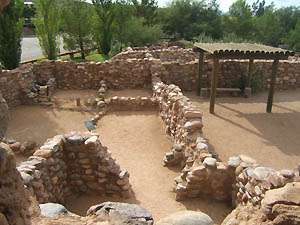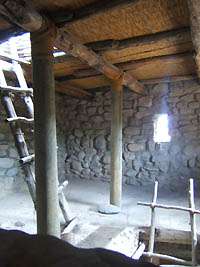Besh-Ba-Gowah Archaeological Park
category : Archaeology
 Besh-Ba-Gowah is an ancient ruin unlike the others. Here you are encouraged to walk within the rooms of this 700 year old pueblo, climb ladders into the upper stories, and see the utensils, pottery and furbishings that were a part of life in pre-Columbian times.
Besh-Ba-Gowah is an ancient ruin unlike the others. Here you are encouraged to walk within the rooms of this 700 year old pueblo, climb ladders into the upper stories, and see the utensils, pottery and furbishings that were a part of life in pre-Columbian times.You enter Besh-Ba-Gowah in the same way as the original residents, through the central corridor. This narrow, windowless passage was thought to channel all the traffic to the center of activity within the pueblo, the central plaza.
The plaza was the focal point of the ancient community where public ceremonies were held and many dead were buried. We also know that the plaza was the center of commerce. During excavation, jewelry was found made with shells that can be traced to the Pacific Ocean, Gulf of California, and Gulf of Mexico - evidence that commerce and trading were widespread during these ancient times.
The pueblo was built in stories. Many of the ground floor rooms were used for storage as upper stories were added for living areas. Several of these rooms have been almost completely restored and contain the types of tools and pottery which were excavated at the site.
 By climbing the re-created ladder, you can go from the ground floor to the second story exactly as the Salado did and enter a typical living area. Another ladder protruding through the roof hatch permitted the original residents access to the place where the Salado spent much of their time, the roof. In the typical pueblo, the rooftops were the center of the traffic flow within the community.
By climbing the re-created ladder, you can go from the ground floor to the second story exactly as the Salado did and enter a typical living area. Another ladder protruding through the roof hatch permitted the original residents access to the place where the Salado spent much of their time, the roof. In the typical pueblo, the rooftops were the center of the traffic flow within the community.It is believed that the earliest residents of the site were the Hohokam, who established a pit-house settlement here around A.D. 900 and abandoned it around A.D. 1100. At approximately 1225, the Salado Indians began constructing the pueblo that stands today. Shortly after A.D. 1400, the pueblo was abandoned and the civilization of the Salado people mysteriously disappeared. It is believed that this is linked to climatic changes that caused a shortage of water which may have resulted in an increase of warfare. The area apparently remained uninhabited for centuries until the Apache people made it their homeland sometime after A.D. 1600. The name Besh-Ba-Gowah comes from the Apache language and translates to English as "place of metal" or "metal camp."
Visitors can start tours with a short video in the Auditorium depicting the Salado history and way of life, the coming of Apaches, miners and settlers. The video also includes information regarding the re-excavating of the ruins. The museum houses the world's largest single collection of Salado pottery as well as clothing, tools, and other artifacts.
Admission: Reasonable fees
Address: 1324 S. Jesse Hayes Rd., Globe, Arizona
Phone: 928-425-0320
Our Email: beshbagowah@globeaz.gov
Our Website:www.globeaz.gov/visitors/besh-ba-gowah
Come visit us in Arizona, Arizona